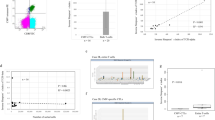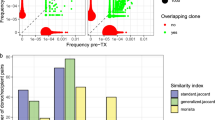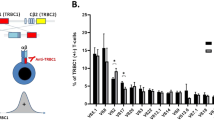Abstract
We have previously reported that skewed repertoires of T cell receptor-β chain variable region (TCRBV) and TCR-α chain variable region (TCRAV) are observed at an early period after allogeneic hematopoietic cell transplantation. Furthermore, we found that T lymphocytes using TCRBV24S1 were increased in 28% of the recipients of allogeneic grafts and an increase of TCRBV24S1 usage was shown to result from clonal expansions. Interestingly, the arginine residue was frequently present at the 3′ terminal of BV24S1 segment and was followed by an acidic amino acid residue within the CDR3 region. These results suggest that these clonally expanded T cells are not randomly selected, but are expanded by stimulation with specific antigens. This study was undertaken to elucidate the mechanisms of the post-transplant skewing of TCR repertoires. Since the CD8+CD28−CD57+ T cell subset has been reported to expand in the peripheral blood of patients receiving allogeneic hematopoietic cell grafts, we examined the TCRAV and TCRBV repertoires of the CD8+CD28− T cell and CD8+CD28+ T cell subsets, and also determined the clonality of both T cell populations. In all three recipients examined, the CD8+CD28− T cell subset appeared to define the post-transplant TCR repertoire of circulating blood T cells. Moreover, the CDR3 length of TCRBV imposed constraints in both CD8+CD28− T cell and CD8+CD28+ T cell subsets. The DNA sequences of the CDR3 region were determined, and the same clones were identified within both CD8+CD28− and CD8+CD28+ T cell subsets in the same individuals. These results suggest that the clonally expanded CD8+CD28− T cells after allogeneic hematopoietic cell transplantation derive from the CD8+CD28+ T cell subset, possibly by an antigen-driven mechanism, resulting in the skewed TCR repertoire. Bone Marrow Transplantation (2001) 27, 731–739.
This is a preview of subscription content, access via your institution
Access options
Subscribe to this journal
Receive 12 print issues and online access
$259.00 per year
only $21.58 per issue
Buy this article
- Purchase on Springer Link
- Instant access to full article PDF
Prices may be subject to local taxes which are calculated during checkout





Similar content being viewed by others
References
June CH, Bluestone JA, Nadler LM, Thompson CB . The B7 and CD28 receptor families Immunol Today 1994 15: 321–331
Azuma M, Phillips JH, Lanier LL . CD28− T lymphocytes: antigenic and functional properties J Immunol 1993 150: 1147–1159
Brinchmann JE, Dobloug JH, Heger BH et al. Expression of costimulatory molecule CD28 on T cells in human immunodeficiency virus type 1 infection: functional and clinical correlations J Infect Dis 1994 169: 730–738
Lewis DE, Tang DS, Adu Oppong A et al. Anergy and apoptosis in CD8+ T cells in HIV-infected persons J Immunol 1994 153: 412–420
Leroy E, Calvo CF, Divine M et al. Persistence of T8+/HNK-1+ suppressor lymphocytes in the blood of long-term surviving patients after bone marrow transplantation J Immunol 1986 137: 2180–2189
Hammann D, Roos MThL, van Lier RAW . Faces and phases of human CD8+ T-cell development Immunol Today 1999 20: 177–180
Matsutani T, Yoshioka T, Tsuruta Y et al. Restricted usage of TCRAV and TCRBV repertoires after human allogeneic hematopoietic transplantation Br J Haematol 2000 109: 759–769
Gorochov G, Debre P, Leblond V et al. Oligoclonal expansion of CD8+CD57+ T cells with restricted T-cell receptor β chain variability after bone marrow transplantation Blood 1994 83: 587–595
Masuko K, Kato S, Hagihara M et al. Stable clonal expansion of T cells induced by bone marrow transplantation Blood 1996 87: 789–799
Storb R, Deeg HJ, Whitehead J et al. Methotrexate and cyclosporine compared with cyclosporine alone for prophylaxis of acute graft versus host disease after marrow transplantation for leukemia New Engl J Med 1986 314: 729–735
Glucksberg H, Storb R, Fefer A et al. Clinical manifestations of graft-versus-host disease in human recipients of marrow from HLA-matched sibling donors Transplantation 1974 18: 295–304
Boeckh M, Bowden RA, Goodrich JM et al. Cytomegalovirus antigen detection in peripheral blood leukocytes after allogeneic marrow transplantation Blood 1992 80: 1358–1364
Yau JC, Dimopoulos MA, Huan SD et al. Prophylaxis of cytomegalovirus infection with ganciclovir in allogeneic marrow transplantation Eur J Haematol 1991 47: 371–376
Hirokawa M, Gray JD, Takahashi T, Horwitz DA . Human resting B lymphocytes can serve as accessory cells for anti-CD2-induced T cell activation J Immunol 1992 149: 1859–1866
Matsutani T, Yoshioka T, Tsuruta Y et al. Analysis of TCRAV and TCRBV repertoires in healthy individuals by microplate hybridization assay Hum Immunol 1997 56: 57–69
Pannetier C, Cochet M, Darche S et al. The sizes of the CDR3 hypervariable regions of the murine T-cell receptor beta chains vary as a function of the recombined germ-line segments Proc Natl Acad Sci USA 1993 90: 4319–4323
Cochet M, Pannetier C, Regnault A et al. Molecular detection and in vivo analysis of the specific T cell response to a protein antigen Eur J Immunol 1992 22: 2639–2647
Hirokawa M, Horiuchi T, Kitabayashi A et al. Delayed recovery of CDR3 complexity of the T cell receptor β chain in recipients of allogeneic bone marrow transplants who had virus-associated interstitial pneumonia: monitor of T-cell function by CDR3 spectratyping J Aller Clin Immunol 2000 106: 32–39
Kitabayashi A, Hirokawa M, Hatano Y et al. Granulocyte colony-stimulating factor down-regulates allogeneic immune responses by post-transcriptional inhibition of tumor necrosis factor-α production Blood 1995 86: 2220–2227
Kawabata Y, Hirokawa M, Kitabayashi A et al. Defective apoptotic signal transduction pathway downstream of caspase-3 in human B-lymphoma cells: a novel mechanism of nuclear apoptosis resistance Blood 1999 94: 3523–3530
Yoshioka T, Matsutani T, Iwagami S et al. Quantitative analysis of the usage of human T cell receptor alpha and beta chain variable regions by reverse dot blot hybridization J Immunol Meth 1997 201: 145–155
Hirokawa M, Horiuchi T, Kawabata Y et al. Reconstitution of γδ T-cell repertoire diversity after human allogeneic hematopoietic cell transplantation and the role for peripheral expansion of mature T-cell population in the graft Bone Marrow Transplant 2000 26: 177–185
Yoshioka T, Matsutani T, Iwagami S et al. Polyclonal expansion of TCRBV2- and TCRBV6-bearing T cells in patients with Kawasaki disease Immunology 1999 96: 465–472
McHeyzer-Williams MG, Davis MM . Antigen-specific development of primary and memory T cells in vivo Science 1995 268: 106–111
Maini MK, Casorati G, Dellabona P et al. T-cell clonality in immune responses Immunol Today 1999 20: 262–266
Concannon P, Robinson MA . Human T-cell receptor gene nomenclature Ann NY Acad Sci 1995 756: 124–129
Nociari MM, Telford W, Russo C . Postthymic development of CD28−CD8+ T cell subset: age-associated expansion and shift from memory to naive phenotype J Immunol 1999 162: 3327–3335
Monteiro J, Batliwalla F, Ostrer H, Gregersen PK . Shortened telomeres in clonally expanded CD28−CD8+ T cells imply a replicative history that is distinct from their CD28+CD8+ counterparts J Immunol 1996 156: 3587–3590
Fiorentini S, Malacarne F, Ricotta D et al. Generation of CD28− cells from long-term-stimulated CD8+CD28+ T cells: a possible mechanism accounting for the increased number of CD8+CD28− T cells in HIV-1-infected patients J Leukoc Biol 1999 65: 641–648
Mugnaini EN, Spurkland A, Egeland T et al. Demonstration of identical expanded clones within CD8+CD28+ and CD8+CD28− T cell subsets in HIV type 1-infected individuals Eur J Immunol 1998 28: 1738–1742
Akolkar PN, Gulwani-Akolkar B, Pergolizzi R et al. Influence of HLA genes on T cell receptor V segment frequencies and expression levels in peripheral blood lymphocytes J Immunol 1993 150: 2761–2773
Wang ECY, Moss PAH, Frodsham P et al. CD8highCD57+ T lymphocytes in normal, healthy individuals are oligoclonal and respond to human cytomegalovirus J Immunol 1995 155: 5046–5056
Weekes MP, Wills MR, Mynard K et al. Large clonal expansions of human virus-specific memory cytotoxic T lymphocytes within the CD57+CD28−CD8+ T-cell population Immunology 1999 98: 443–449
Weekes MP, Carmichael AJ, Wills MR et al. Human CD28-CD8+ T cells contain greatly expanded functional virus-specific memory CTL clones J Immunol 1999 162: 7569–7577
Lewis DE, Yang L, Luo W et al. HIV-specific cytotoxic T lymphocyte precursors exist in a CD28−CD8+ T cell subset and increase with loss of CD4 T cells AIDS 1999 13: 1029–1033
Dalod M, Sinet M, Deschemin JC et al. Altered ex vivo balance between CD28+ and CD28− cells within HIV-specific CD8+ T cells of HIV-seropositive patients Eur J Immunol 1999 29: 38–44
Caruso A, Licenziati S, Canaris AD et al. Contribution of CD4+, CD8+CD28+, and CD8+CD28− T cells to CD3+ lymphocyte homeostasis during the natural course of HIV-1 infection J Clin Invest 1998 101: 137–144
Altman JD, Moss PAH, Goulder PJR et al. Phenotypic analysis of antigen-specific T lymphocytes Science 1996 274: 94–96
Engstrand M, Tournay C, Peyrat MA et al. Characterization of CMVpp65-specific CD8+ T lymphocytes using MHC tetramers in kidney transplant patients and healthy participants Transplantation 2000 69: 2243–2250
Acknowledgements
We are grateful to the hematology staff at Akita University Medical Center for their treatment of the patients included in this study. This work was supported by grants from the Ministry of Education, Science, Sports and Culture of Japan (Grant No. 08670508, 10670932), the Yamashita Taro-Kensho Memorial Foundation and the Uehara Memorial Foundation to MH.
Author information
Authors and Affiliations
Rights and permissions
About this article
Cite this article
Horiuchi, T., Hirokawa, M., Kawabata, Y. et al. Identification of the T cell clones expanding within both CD8+CD28+ and CD8+CD28− T cell subsets in recipients of allogeneic hematopoietic cell grafts and its implication in post-transplant skewing of T cell receptor repertoire. Bone Marrow Transplant 27, 731–739 (2001). https://doi.org/10.1038/sj.bmt.1702859
Received:
Accepted:
Published:
Issue Date:
DOI: https://doi.org/10.1038/sj.bmt.1702859
Keywords
This article is cited by
-
CD28neg. T lymphocytes of a melanoma patient harbor tumor immunity and a high frequency of germline-encoded and public TCRs
Immunologic Research (2018)
-
The presence and longevity of peripherally expanded donor-derived TCRαβ+ mature T lymphocyte clones after allogeneic bone marrow transplantation for adult myeloid leukemias
Leukemia (2003)
-
Distinct TCRAV and TCRBV repertoire and CDR3 sequence of T lymphocytes clonally expanded in blood and GVHD lesions after human allogeneic bone marrow transplantation
Bone Marrow Transplantation (2002)



